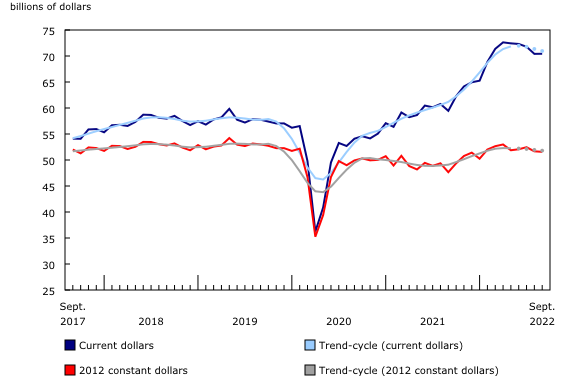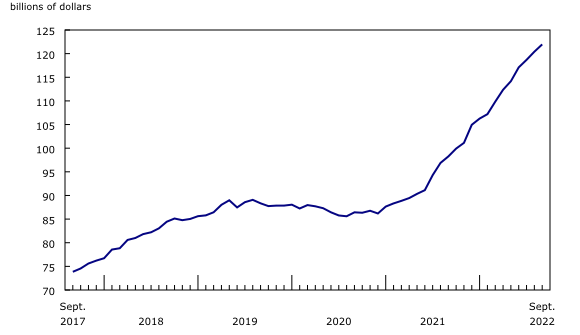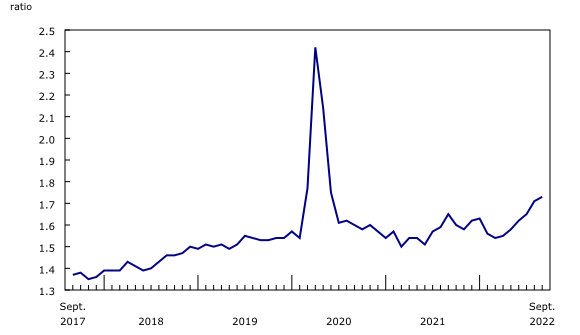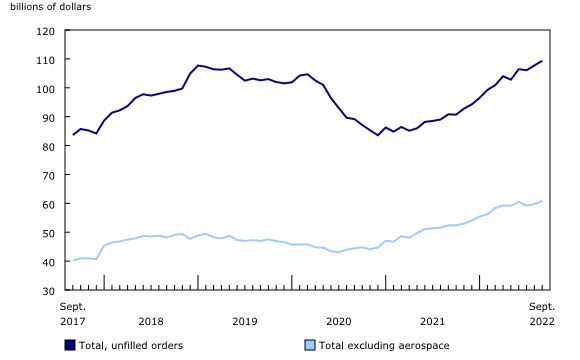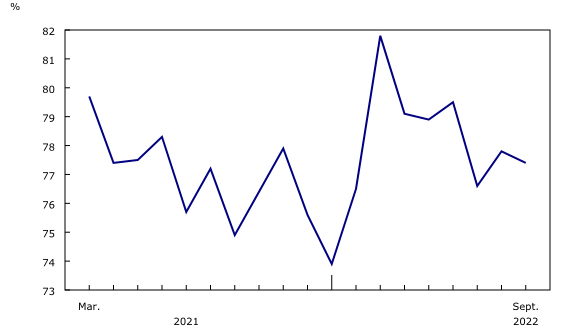Monthly Survey of Manufacturing, September 2022
Released: 2022-11-15
Following four consecutive monthly declines, manufacturing sales were unchanged at $70.4 billion in September. Durable goods were the main source of sales growth in September, increasing 1.0% to $34.1 billion, following a decline of 2.0% in the previous month. Among durable goods manufacturers, aerospace product and parts (+11.1%), primary metal (+2.9%) and machinery (+3.6%) posted the largest gains during the month.
Conversely, sales of non-durable goods were down 0.9% to $36.3 billion in September, driven primarily by the petroleum and coal products (-2.4%) and food (-1.8%) industries.
On a quarterly basis, sales in current dollars decreased for the first time since the second quarter of 2020, down 2.2% to $212.6 billion in the third quarter of 2022. The petroleum product and coal (-9.4%), primary metal (-11.4%) and wood product (-10.8%) industries contributed the most to the declines, while the food industry (+2.6%) posted the largest quarterly increase.
On a monthly basis, sales in constant dollars edged down 0.2% in September, indicating that lower volumes were sold, while the Industrial Product Price Index edged up 0.1% in September. On a quarterly basis, constant dollars sales decreased 0.8% in the third quarter.
Aerospace product and parts industry posts the largest increase
Following a 4.0% decline in August, production in the aerospace product and parts industry rose 11.1% to $1.7 billion in September—this is typical of the last month of the third quarter when deliveries are usually accelerated. A strong US dollar had an important role in the monthly growth as some large aircraft manufacturers reported their value in US dollars. In real terms, production in the industry increased 7.0% in September from the previous month, while on a quarterly basis, production expressed in current dollars increased 2.1%. Additionally, exports of aircraft engines, aircraft parts and other aerospace equipment rose 2.5% in September.
After two consecutive monthly declines, sales of primary metals increased 2.9% to $5.6 billion in September, on higher volumes as the sales in real terms increased 4.2%. Higher sales in non-ferrous metal (except aluminum) production and processing (+22.8%) contributed the most to the monthly increase, as the major manufacturers in this industry ramped up production after unplanned interruptions that occurred in July 2022. Prices for ferrous (+0.3%) and non-ferrous (-0.2%) metal products changed slightly from August to September, while exports of basic and semi-finished products of non-ferrous metals and non-ferrous metal alloys (except aluminum) were up 22.9%. In September, sales on a yearly basis were up 6.0%, but on a quarterly basis were down 11.4%—the first quarterly decline since the second quarter of 2020.
Other main industries that contributed to the monthly growth in the manufacturing sector in September were the machinery (+3.6%) and chemical (+2.1%) industries.
Sales of petroleum and coal continue to decline
Sales in the petroleum and coal industry dipped 2.4% to $9.5 billion in September, marking the fourth consecutive monthly decline. Concerns of a possible macroeconomic slowdown and a volatile crude oil supply affected by geopolitical uncertainties, along with oil refinery maintenance in Eastern Canada contributed to the declines. Prices (-3.0%) and exports (-11.5%) for refined petroleum energy products (including liquid biofuels) both fell. Sales were up 40.3% year over year, despite declines month over month, as well as quarter over quarter (-9.4%).
After reaching a record high in August, sales in the food industry fell 1.8% to $11.9 billion in September, primarily on lower sales of meat products (-8.2%). Prices for meat products declined 1.2% month over month, while the slaughtering report showed a 28.7% increase in red meat production. Despite the monthly declines, sales in the food industry increased 7.4% on a yearly basis and set a record high on a quarterly basis, up 2.6% to $35.8 billion in the third quarter. Sales volume declined 2.8% in September.
Other industries that contributed to the monthly decline in the manufacturing sector in September were the motor vehicle (-5.5%) and wood (-2.3%) industries.
Higher sales in Quebec more than offset lower sales elsewhere
Manufacturing sales declined in 8 of 10 provinces in September, led by Ontario. Meanwhile, sales in Quebec increased the most.
In Ontario, sales declined 1.2% to $30.6 billion in September, the second consecutive decline. A decrease in sales of motor vehicles (-6.2%) was the main contributor to the decline as shutdowns and a lack of raw materials at some major auto plants impacted sales. The decrease was partially offset by an increase in the chemical manufacturing industry (+4.1%). After four consecutive quarterly gains, sales in Ontario declined 0.4% to $92.5 billion in the third quarter of 2022. Despite the decrease, total sales were up 20.9% compared with September 2021.
Sales in Quebec increased 4.1% to $17.5 billion in September, after two consecutive monthly declines. Increases in the primary metal (+13.3%), aerospace product and parts (+14.9%) and machinery (+14.2%) industries contributed the most to the increase.
Toronto sales decrease the most
Manufacturing sales fell in 7 of 15 selected census metropolitan areas in September, led by Toronto and Edmonton, while sales in Montréal increased the most.
After a 1.8% increase in August, sales in Toronto decreased 3.1% to $11.7 billion in September. Sales of motor vehicles declined 32.0% to $945 million, the lowest level since April 2021 and the main contributor to the decrease in manufacturing sales in Toronto.
Sales in Edmonton decreased 2.4% to $4.4 billion in September 2022, mainly on lower sales of petroleum and coal (-2.2%), primary metal (-30.4%) and food (-5.7%). Despite the decline, sales were up 50.9% on a yearly basis.
After two consecutive monthly declines, sales in Montréal increased 2.3% to $7.9 billion in September, the fourth highest level on record. Sales in the aerospace product (+15.0%), machinery (+19.7%) and primary metal (+2.9%) industries were the main contributors to the increase.
Levels of inventory continue to increase
Total inventory levels continued to strengthen since the beginning of the 2021, up 1.3% to $122.0 billion in September, on higher inventories in 15 of 21 industries led by the transportation equipment (+3.4%), fabricated metal product (+4.3%) and machinery (+2.9%) industries. The gains were partly offset by declines in the primary metal (-2.3%), petroleum and coal product (-2.4%), and beverage and tobacco product (-3.9%) industries. All three components of total inventories were up, with raw materials increasing by 1.8%, goods in process by 1.3% and finished products by 0.5%.
The inventory-to-sales ratio increased from 1.71 in August to 1.73 in September. This ratio measures the time, in months, that would be required to exhaust inventories if sales were to remain at their current level.
Unfilled orders rise
The total value of unfilled orders rose 1.5% to $109.4 billion in September, on higher unfilled orders in the transportation equipment (+1.5%), machinery (+1.7%) and food (+15.4%) industries. The increase was partially offset by lower unfilled orders in the wood product industry (-5.5%). Total value of unfilled orders was up 20.4% on a year-over-year basis.
The total value of new orders increased 0.1% to $72.1 billion in September, mainly on higher new orders of machinery (+13.2%) and was partially offset by lower new orders in the transportation equipment industry (-8.0%).
Capacity utilization rate decreases
The capacity utilization rate (not seasonally adjusted) for the manufacturing sector decreased from 77.8% in August to 77.4% in September.
The capacity utilization rate fell in 9 of 21 industries in September, particularly in the petroleum and coal product (-4.1 percentage points) and transportation equipment (-3.1 percentage points) industries.
The decreases were partially offset by a higher capacity utilization rate in the primary metal (+5.7 percentage points) and fabricated metal product (+3.9 percentage points) industries.
Sustainable development goals
On January 1, 2016, the world officially began implementing the 2030 Agenda for Sustainable Development—the United Nations' transformative plan of action that addresses urgent global challenges over the following 15 years. The plan is based on 17 specific sustainable development goals.
The Monthly Survey of Manufacturing is an example of how Statistics Canada supports the reporting on the global sustainable development goals. This release will be used to help measure the following goal:

Note to readers
Monthly data in this release are seasonally adjusted and are expressed in current dollars, unless otherwise specified.
Seasonally adjusted data are data that have been modified to eliminate the effect of seasonal and calendar influences to allow for more meaningful comparisons of economic conditions from period to period. For more information on seasonal adjustment, see Seasonally adjusted data – Frequently asked questions.
Trend-cycle estimates are included in selected charts as a complement to the seasonally adjusted series. These data represent a smoothed version of the seasonally adjusted time series and provide information on longer-term movements, including changes in direction underlying the series. For information on trend-cycle data, see Trend-cycle estimates – Frequently asked questions.
Both seasonally adjusted data and trend-cycle estimates are subject to revision as additional observations become available. These revisions could be large and could even lead to a reversal of movement, especially for reference months near the end of the series or during periods of economic disruption.
Non-durable goods industries include food; beverage and tobacco products; textile mills; textile product mills; clothing; leather and allied products; paper; printing and related support activities; petroleum and coal products; chemicals; and plastics and rubber products.
Durable goods industries include wood products; non-metallic mineral products; primary metals; fabricated metal products; machinery, computer and electronic products; electrical equipment; appliances and components; transportation equipment; furniture and related products; and miscellaneous manufacturing.
Production-based industries
For the aerospace and shipbuilding industries, the value of production is used instead of the value of sales of goods manufactured. The value of production is calculated by adjusting monthly sales of goods manufactured by the monthly change in inventories of goods in process and finished products manufactured. The value of production is used because of the extended period of time that it normally takes to manufacture products in these industries.
Unfilled orders are a stock of orders that will contribute to future sales, assuming that the orders are not cancelled.
New orders are those received, whether sold in the current month or not. New orders are measured as the sum of sales for the current month plus the change in unfilled orders from the previous month to the current month.
Manufacturers reporting sales, inventories and unfilled orders in US dollars
Some Canadian manufacturers report sales, inventories and unfilled orders in US dollars. These data are then converted to Canadian dollars as part of the data production cycle.
For sales, based on the assumption that they occur throughout the month, the average monthly exchange rate for the reference month established by the Bank of Canada is used for the conversion. The monthly average exchange rate is available in table 33-10-0163-01. Inventories and unfilled orders are reported at the end of the reference period. For most respondents, the daily average exchange rate on the last working day of the month is used for the conversion of these variables.
However, some manufacturers choose to report their data as of a day other than the last working day of the month. In these instances, the daily average exchange rate on the day selected by the respondent is used. Note that because of exchange rate fluctuations, the daily average exchange rate on the day selected by the respondent can differ from both the exchange rate on the last working day of the month and the monthly average exchange rate. Daily average exchange rate data are available in table 33-10-0036-01.
Revision policy
Each month, the Monthly Survey of Manufacturing releases preliminary data for the reference month and revised data for the previous three months. Revisions are made to reflect new information provided by respondents and updates to administrative data.
Once a year, a revision project is undertaken to revise multiple years of data.
Real-time data tables
Real-time data tables 16-10-0118-01, 16-10-0119-01, 16-10-0014-01 and 16-10-0015-01 will be updated on November 22.
Next release
Data from the Monthly Survey of Manufacturing for October will be released on December 14.
Contact information
For more information, or to enquire about the concepts, methods or data quality of this release, contact us (toll-free 1-800-263-1136; 514-283-8300; infostats@statcan.gc.ca) or Media Relations (statcan.mediahotline-ligneinfomedias.statcan@statcan.gc.ca).
- Date modified:


